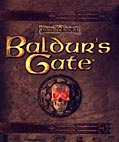
Setting the RPG gaming standard.
Ironically, attempts at storytelling and immersing you in a game world have often been at odds with each other. To tell their stories, game designers have so far taken many of their techniques from film and books and have tried to apply those formats literally to games. These techniques might advance a plot, but instead of drawing you into a world, they more often draw you out of it by forcing you to experience it passively.
Take today's computer role-playing games as an example. The pen-and-paper role-playing games that serve as their inspiration grant you an almost magical ability to enter another world imaginatively and interact with its fantastic people and places. You can communicate and act freely, only limited and guided by the game rules. Massively multiplayer online role-playing games have managed to capture a good deal of this freedom. The same isn't yet true of many traditional computer role-playing games that try to tell relatively linear stories. Take games like Baldur's Gate and Baldur's Gate II, superb works that have largely set the standard for computer RPGs. In these games, visuals usually take center stage, and this is no surprise since it's natural to want to see the fantastic realms and creatures of these games.
The way these games use visuals, though, hurts their ability both to tell stories and make you feel like an active part of them. Because of the third-person isometric perspective and the small scale of the figures on screen, playing feels more like watching an animated film than being in the world yourself. Unlike true animated films or live-action movies, you don't have the benefit of close-ups that let you directly see the characters as they speak. You miss the unique facial expressions and body language that say so much. Similarly, you never really get a close look at the fantastic places, people, and creatures that are hinted at on screen.
Clearly, visuals like this can't tell a complex story by themselves, so in many computer RPGs, text is also needed for more detailed descriptions. The great majority of the dialogue in these games also appears as printed text since it would be impractical to record it all with actors. But, dividing a game's presentation between visuals and text further interferes with drawing you into the game world and helping you suspend your disbelief. It's like sitting in a movie theater where the lights go on and the reel stops whenever there's dialogue, so you can read it in a provided script. Neither the visuals nor the text receive the full focus like they do in films and books, so both suffer and detract from one another.
Next: Cutscenes...



